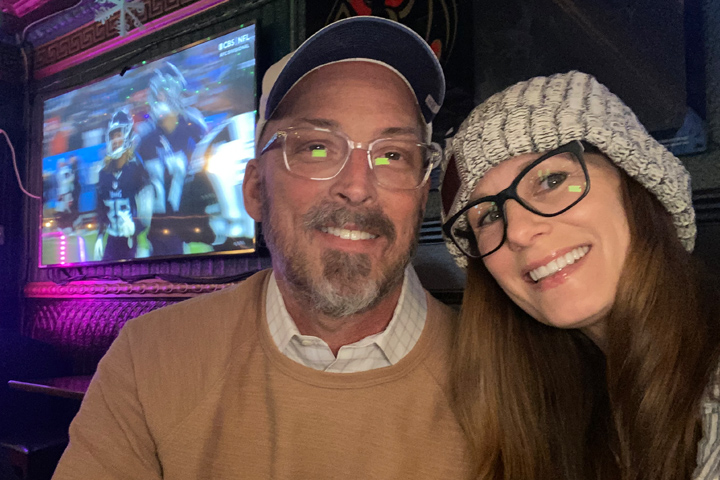My Unexpected Journey

- Intense stomach pain leads to pancreatic cancer diagnosis
- Treatment with FOLFIRINOX
- Staying positive to help others
I will never forget the day when my world was turned upside down: February 7, 2021.
I was 55 years old and couldn’t have been happier with my current lot in life. Both my daughters were young adults at 27 and 25, living on their own, and in a good place. I was engaged to Amber, a beautiful soul, and I was excited to live, experience, and enjoy all of life’s adventures with her. I was the president of my own thriving sales consulting business. And my health was solid, outside of a bad hip from the many miles I’ve logged as a runner since my high school days. My momma always said that I would regret the damage I was inflicting on my body with my runs. Momma was always right!!
In the six months prior to February 7, 2021, I started feeling stomach pains like I’d never previously experienced. Sharp pains that made it difficult to maneuver. The pain got to a point that I would avoid pothole-infested roads when driving, because the jarring would cause me such intense pain. Given my uneventful medical history throughout my life, I initially attributed this pain to simple benign causes like gas, constipation, or possibly a pulled muscle.
But the pain started to worsen and over time, my stomach showed signs of distension. This caused difficulty with basic functions like sleeping, walking, and simply getting up from a chair. My primary care doc suggested a colonoscopy to rule out some more serious things, which I scheduled for January 2021. I was convinced that the prep for the procedure itself would offer some relief to the stomach pain, as it would completely clean me out. The good news is that the colonoscopy was a complete success with no medical concerns. However, my stomach pain and distension were even worse than before.
February 7, 2021 was Super Bowl Sunday. I didn’t sleep well the night before, so I remained in my big recliner chair, taking in some Super Bowl pre-game coverage. It was snowing heavily that day and Amber asked if I wanted to go for a walk into town to take in the beauty. I declined, which, as she put it, was very odd and quite unusual. Later in the day, Amber was outside in our backyard with some neighbors sitting around our firepit. She wanted me to join but I just couldn’t. I felt miserable, and my pain was becoming unbearable. Amber asked one of our neighbors, an ER nurse, if she would give me a once-over while she was over. The minute our friend saw me, without performing any diagnostic exercise, she knew that I needed to be seen by a doctor ASAP. Ten minutes later, Amber and I were on our way to the ER.
An Answer to My Pain
In my mind, the worst-case diagnosis was nothing more than appendicitis . . . removing an appendix is a straightforward procedure, relatively speaking. The doc can go in, slice it out, and I would be back home the next day feeling back to normal. BOOM. It’s that simple!
Upon our arrival to the ER, the staff quickly got me situated so they could start the pokes and prods along with some blood work and CT scans. After six hours, Amber and I were waiting for the anticipated appendicitis diagnosis, so we could be on our way toward recovery. Not so fast . . . the doc came in, said that she had some bad news, and informed us that I had cancer. We were shocked and our bodies turned numb. Amber and I both cried, not sure what to say. Anything said after that remains a blur. But I was going to have to stay at the hospital for the next several days for additional testing and a paracentesis. Paracentesis is a procedure that removes fluid (peritoneal fluid) from the abdomen through a slender needle. The collected fluid is then sent to a lab for analysis to determine the cause of the excess fluid. They ended up removing four to five 2-liter bottles worth of peritoneal fluid. What a relief!!
By the time I left the hospital, I was already scheduled to meet with my lead oncologist, Dr. Sarah Goodyear of Alliance Cancer Specialists, in Bucks County, Pennsylvania, where I live. At this appointment, Dr. Goodyear laid out the plan to take on the fight of my life against stage IV pancreatic cancer. A close colleague of Dr. Goodyear’s, Dr. Ryan Massa (University of Pennsylvania) was also part of my medical support team, to keep us informed of appropriate clinical trials.
The Treatment Plan
The standard of care for my type of cancer is called FOLFIRINOX, a cocktail of different chemotherapies administered by way of IV every two weeks—fluorouracil, oxaliplatin, folinic acid (leucovorin), and irinotecan. Unlike most patients receiving chemo with a definitive start and end date, my plan started on March 1, 2021, with no end noted. As the doctor said, I will always be on some type of chemo, as long as I can handle it. That was definitely a punch in the gut.
There was one chemo session about five months in where I happened to see a fellow patient announce to the room that THIS was her final treatment of her six-month treatment plan!! And everyone—staff and fellow patients alike—cheered as she exited, stage left. While I was more than thrilled for this patient and her accomplishment, I could not help but feel defeated as I knew that I would never experience this same “I’m done with chemo!!” elation! In fact, my nurse that day must’ve noticed a change in my demeanor and asked how I was doing. I responded with an “ok” that, I guess, wasn’t convincing. She asked me again, which led to some raw and tearful emotions from me. She stayed with me for the rest of my session that day, allowing me to feel what I was feeling. Thank God for the nurses who care for us during these chemo treatments. On that day, I needed her shoulder to cry on.
Life with Pancreatic Cancer
Over the last year, there have been some good days and not-so-good days. Luckily for me, I have more good days than bad. And it’s not a bad thing to fully embrace and genuinely feel both. I always say that you must experience the bad to know and appreciate the good. My medical teams are scratching their heads, trying to understand why I have tolerated the treatments so well, one full year in. They look at me today versus when I first started this journey and swear that I look healthier now than I did then. I guess that’s a good thing to hear. But they ask why. So, with some reflection, I tell them that it all comes down to a few critical components.
- Embrace the process. It can be a scary process at times. Be keep your eye on the prize—your improved health.
- Be your own advocate and never be afraid to ask the most obvious questions. Don’t blindly rely on the healthcare provider . . . . be part of the decision-making process.
- Take this experience and translate it into ways that will allow you to live your life in the most positive way. Everything has a silver lining. In some cases, you just need to look harder to find it.
- Share your entire journey with your supporters . . . the good, bad, and ugly. CaringBridge is great for doing this. But also find ways to be more involved with supporting others going through this same process.
- Don’t fall into the “self-diagnosis with Google” trap. Nothing good comes from that.
Once the diagnosis became our new reality, I had a choice to make. View my cancer as a certain death sentence; OR I can look beyond the diagnosis and fight like hell to beat this cancer down. I chose the latter. I am convinced that this mindset helped me in so many ways. Oddly, I would consider myself the luckiest guy around. Now this may sound crazy coming from someone with stage IV pancreatic cancer. But truly, I view each new day as a blessing . . . an opportunity to share space and make memories with those people I love.
Almost two years after his diagnosis, Roger passed away. During his treatment, he made the most of his time working with patients and serving on the Let’s Win Board of Directors as our first patient member. Roger also cofounded our Patient Advisory Board. He will be missed by his family and friends everywhere, and we offer our deepest sympathy to his family.




